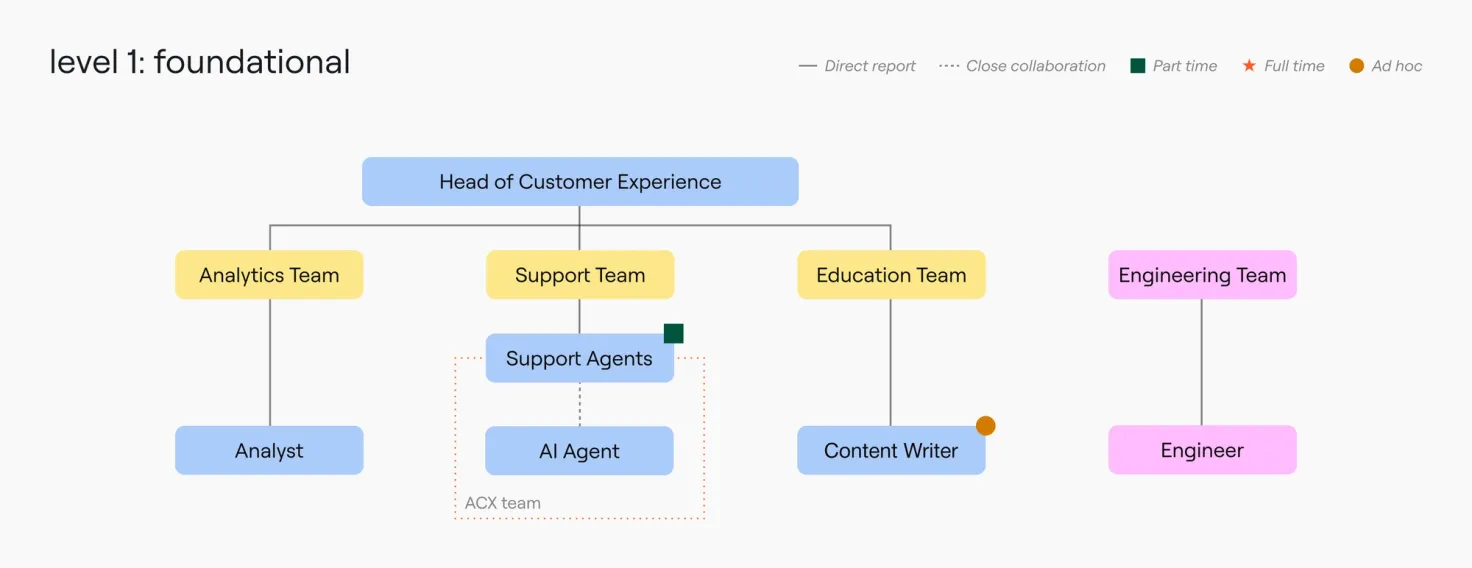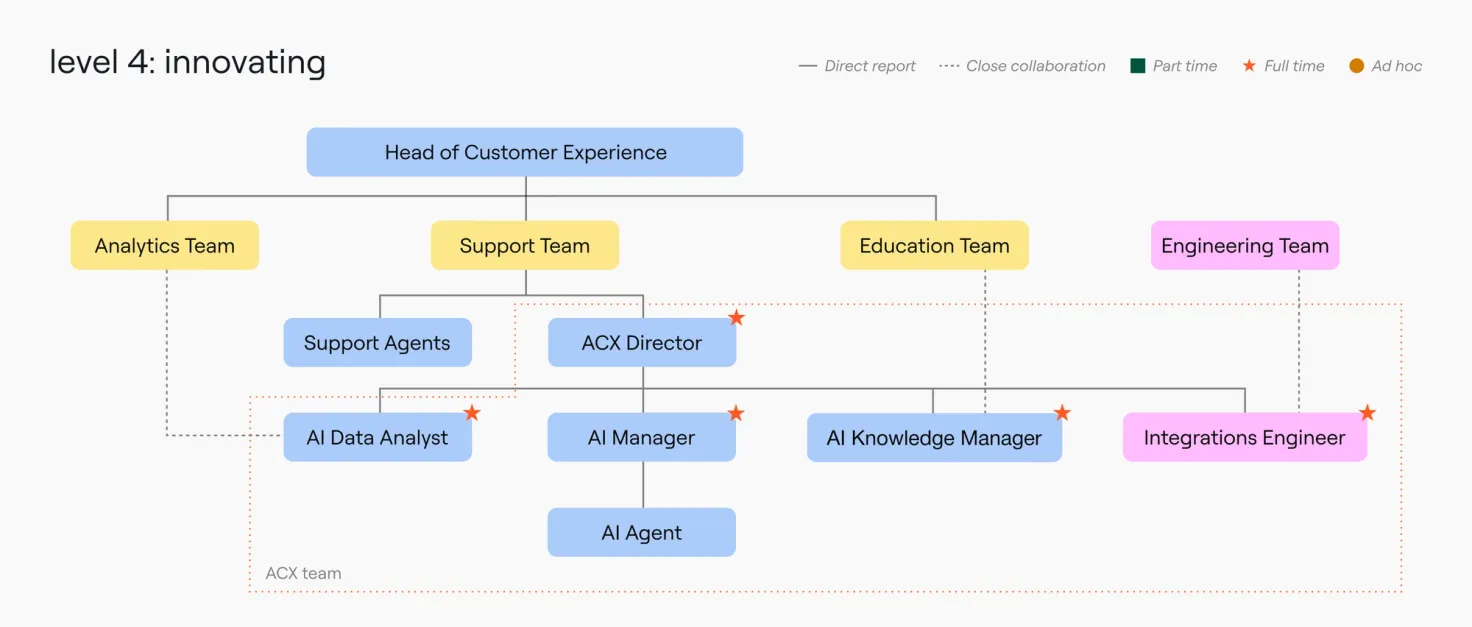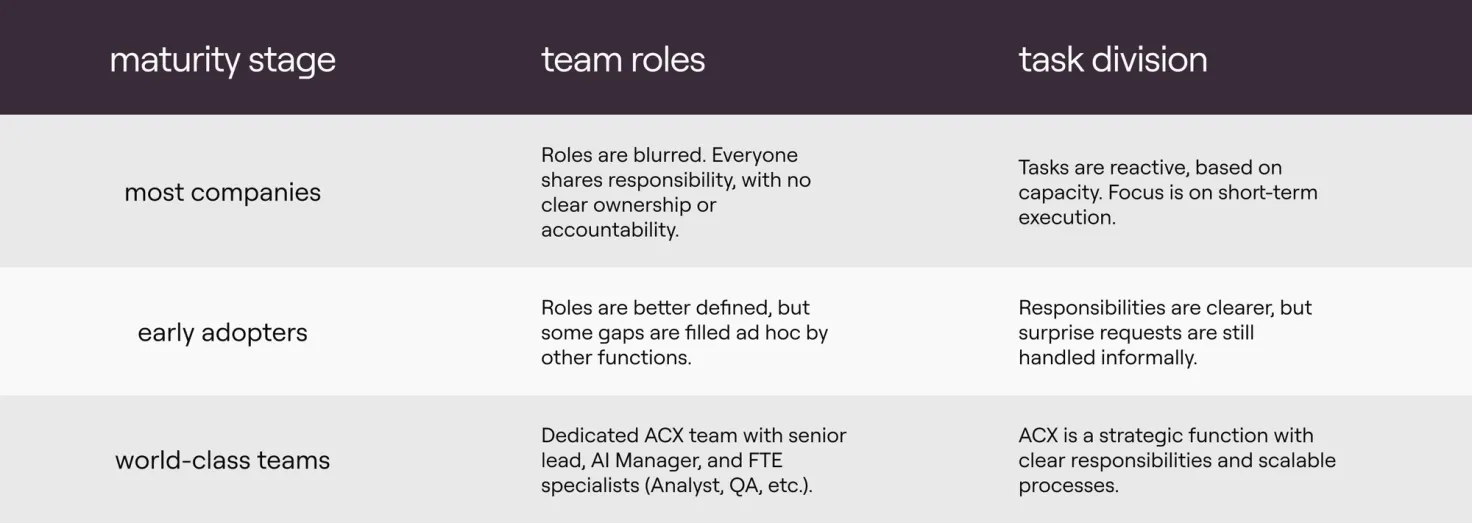
Phase Zero: How to build the business case for upgrading to an AI Voice agent
Get access to this exclusive session on-demand and discover how to turn every customer conversation into a competitive advantage.
Learn More

AI didn’t just change how customer service works—it’s changed who’s doing the work.
In many support orgs today, AI agents are handling more customer conversations than live agents. They’re integrated with backend systems, resolving complex issues, and even escalating intelligently when needed.
But while the tech has evolved rapidly, the structure around it hasn’t. Most companies are still running support teams designed for a world of tickets, not tools.
The result? Disconnected ownership. Plateauing performance. Missed opportunity.
Forward-looking companies are doing something different. They’re redesigning their org charts to reflect a new reality —where AI isn’t an experiment, but a core channel. And they’re building teams around it.
This isn’t just a new workflow. It’s a new operating model with a new name: the AI customer service team . And your org chart needs to catch up.
Support orgs weren’t always broken, they were just built for a different era. In the legacy model, customer service was a human function. More customers meant more agents. Escalations were vertical. Quality assurance focused on scripts and empathy.
A typical structure looked like this:
This setup worked when live agent volume was the primary lever to pull. But as AI starts to take a more commanding role in customer service, and as LLMs constantly evolve , cracks start to show:
In this model, AI ownership gets lost in translation. It becomes “everyone’s job,” which usually means it's no one’s job. The org design simply doesn’t map to the complexity of automation.
In short, the traditional org isn’t wrong—it’s just incomplete. It assumes human agents are the only service channel. That’s no longer true.
Today, most customer service orgs sit somewhere in the middle. They’ve adopted an AI agent (or AI agents), but they haven’t updated their team structure to support this shift.
In these hybrid setups, the AI agent is live and handling real volume—but the roles around it haven’t caught up:
While automation exists in the hybrid model, it isn’t fully operationalized. Support teams are getting value from AI—but they’re not maximizing it. It looks something like this:
This gets you started, but not scaled. As AI maturity increases, the limitations of the hybrid model become clear:
It works until it doesn’t. Without clear ownership, AI agents hit a performance ceiling. Escalations are inconsistently routed. Knowledge gets stale. Updates lag behind product changes.
What’s missing is a structure that treats AI like a teammate—not a tool. That’s where AI-first orgs set themselves apart.

Future-ready teams are doing it differently; they’re structuring around AI, not just experimenting with it.
This is the AI Customer Experience (ACX) model —a programmatic, cross-functional approach to managing automation as a core service channel. With specialized roles, clear ownership, and a mandate to continuously improve, the AI agent is treated like a team member with KPIs, feedback loops, and a coaching structure.
The key to thriving in this AI era is knowing exactly what’s needed to launch and grow a successful AI Customer Experience (ACX) program.
Get the guide
A typical AI-first org structure has a Head of CX or COO overseeing ACX Director that leads an AI program team with dedicated roles, including:
Each role exists to make sure the AI agent is not just present, but excellent. This setup allows teams to move faster, iterate often, and build automation into the foundation of service delivery—not tack it on at the edges.
The payoff? Higher resolution rates, faster learning cycles, and a team that actually trusts the automation.

Now let’s zoom into the roles themselves—because your structure isn’t just boxes and lines. It defines who owns outcomes.
ACX Director
The ACX Director reports to the VP of CX or COO. Their core responsibilities are:
This person is the air traffic controller. They make sure AI isn’t siloed or under supported—and that it’s tied directly to CX goals.
AI Manager
The AI Manager reports to the ACX Director or Support Ops Lead, with core responsibilities of:
They’re not just managing performance—they’re shaping the AI’s behavior. Think: part conversation designer, part product owner.
AI Knowledge Manager
The AI Knowledge Manager reports to the ACX Director or Education Lead. Their core responsibilities are to:
This role ensures the AI always has access to the right answer. No stale articles. No misaligned data.
Automation QA Specialist
The Automation QA Specialist reports to the ACX Director or Ops. Their core responsibilities are:
As AI systems grow more complex, QA becomes critical. This person protects your brand from unintended responses—and ensures trust in the channel.
AI Data Analyst
An AI Data Analyst typically reports to Analytics or the ACX Director, with core responsibilities of:
Without this role, automation becomes anecdotal. With it, it becomes a data-driven discipline.
Integrations Engineer (dotted-line or embedded)
If you choose to add an Integrations Engineer to the ACX team, they would report to Engineering or the CX Tech Lead. Their core responsibilities are:
This is how your AI Agent moves from “answering questions” to “getting things done.” Together, these roles form a self-sustaining program: one that improves, learns, and drives impact without requiring constant executive babysitting.
To recap, In this structure:

AI is no longer a side channel—it’s the front door to your brand. And if your org chart doesn’t reflect that, you’re flying blind.
The best support teams today aren’t just automating more. They’re thinking differently about how their teams are built—assigning clear ownership, defining new roles, and building infrastructure that supports AI the same way they support human agents.
This isn’t a future trend. It’s a current imperative. Your org chart is your AI strategy.Build it like you mean it.
Don’t let an outdated team structure hold you back. Start building a customer service team that uses both AI and human agents to their fullest potential.
Get the guide